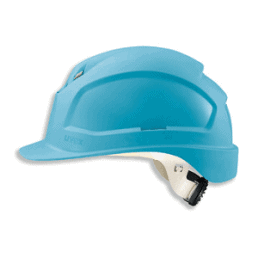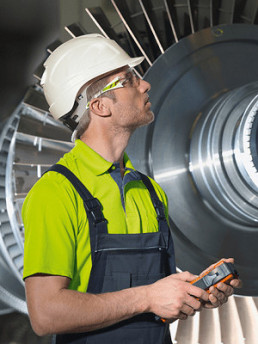The uvex i-performance product system supports the natural movement of the human body, reducing pressure and stresses while also maximising comfort. Constant further development of our products is carried out on the basis of the latest physiological research and technology, thereby ensuring optimum performance with quantifiable product benefits.

The new uvex 9780 antistatic helmet falls under this category and offers an unparalleled level of protection. The merest spark can cause an explosion in environments which contain combustible gas, mist, vapours or dust clouds. It is therefore essential that employees are reliably protected against electrical discharge in many industrial workplaces. Specific danger areas where hazardous atmospheres mean that explosions are likely are divided into various zones.
The uvex 9780 antistatic is a helmet perfectly suited to being worn in explosive environments. It offers optimal protection for all danger groups and zones, in accordance with EN 60079 – 0 in connection with ATEX – guideline 94/9/EG.
What actually are explosive atmospheres and what do these zones mean?
As defined in the DSEAR, an explosive atmosphere is a mixture of dangerous substances with air, under atmospheric conditions, in the form of gases, vapours, mist or dust in which, after ignition has occurred, combustion spreads to the entire unburned mixture. When an atmosphere like this appears in dangerous quantities, meaning that certain safety measures must be implemented in order to maintain the protection of employees’ health and safety, then one can speak of a dangerous, explosive atmosphere.
These dangerous, explosive atmospheres are divided into fundamental zones (Zone 0, Zone 1, Zone 2, Zone 20, Zone 21, Zone 22 and Zone 23):- Zone 0: Danger zone in which an explosive atmosphere of gases, vapours or mist is present continuously or for long periods or frequently
- Zone 1: Danger zone in which an explosive atmosphere of gases, vapours or mist is likely to occur in normal operation.
- Zone 2: Danger zone in which an explosive atmosphere of gases, vapours or mist is not likely to occur in normal operation and if it occurs it will exist only for a short time
- Zone 20: Danger zone in which an explosive atmosphere of dust is continuously present or present for long periods
- Zone 21: Danger zone in which an explosive atmosphere of dust is likely to occur in normal operation
- Zone 22: Danger zone in which an explosive atmosphere of dust is not likely to occur in normal operation and if it occurs it will exist only for a short time
(Zone 0 is the most hazardous danger zone in which explosive atmospheres are present)
So what causes explosions?
Explosions are caused when the right air to gas ratio occurring at the same time as an ignition source becomes active. In addition, explosives can be caused by fluids and solids if these are finely dispersed, again in an atmosphere in which the air ration and ignition source are conducive.
Explosions with dangerous effects can occur when the following conditions are present at the same time and place:
- Flammable substance (concentration in air within the explosion arealimits and sufficiently finely dispersed)
- Oxygen in sufficiently high concentration
- Effective source of ignition with sufficient energy
If just one of these factors is missing, no explosion can occur.
How does the uvex 9780 antistatic helmet ensure electrostatic discharge?

The innovative material used to manufacture the uvex 9780 antistatic reduces ohmic resistance and deflects excess electrical discharge away safely and securely.
This is the first helmet on the market to provide employees with suitable protective headwear for working in closed containers and pipeline systems, as well as while equipping plants where flammable liquids can be found and explosive gases can build up (Zone O). Typical working environments include mining, the petrochemical industry and oil rigs, for example.
Please do not hesitate to contact us with any questions on the uvex i-Performance product system.
Please email expertenblog@uvex.de and we will be happy to help.